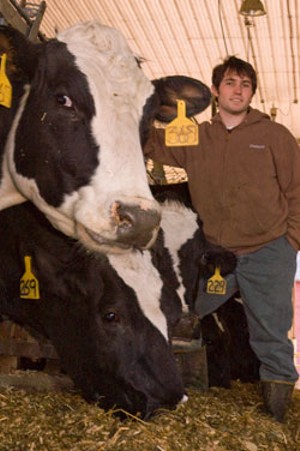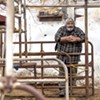Published December 9, 2009 at 7:12 a.m.
Mike Fitzgerald learned to drive when he was 7. Too short to reach the pedals, he would lean against the seat and steer the Allis-Chalmers 60-60 tractor down to the hay fields outlined by the serpentine turns of the Winooski River. At the age of 10, he was milking the cows on his parents’ 150-acre dairy farm by himself. As an adolescent, Fitzgerald preferred farm chores to video games. Even in high school, when his friends from Rice Memorial would go out on Friday nights, Fitzgerald would hang back at the barn. It was all the excitement he needed.
Andrew Wood grew up on a hilly farm east of St. Johnsbury. He excelled in math and science in school and saw early on how the principles of animal biology and photosynthesis came alive in his backyard. When the time arrived to go to college, he considered just two: the University of Vermont and Vermont Technical College. Convinced he was destined to run a dairy farm, Wood wanted to learn all that Vermont’s agricultural schools could teach him.
Hannah Fay loves cows. Holsteins, to be precise. She knows them well, having spent countless hours tending the herd at her parents’ farm in the tiny burg of Brunswick. She met her husband, Chris Fay, another dairy-farm kid, when they were in 4-H. They got married in 2006 and now hope to own and operate Chris’ parents’ farm in nearby Maidstone, a town of 250 souls on the easternmost edge of Vermont.
All these twentysomethings belong to the oft-overlooked demographic of young dairy farmers committed to continuing the family business. They have another thing in common: Most are products of the Farm and Agricultural Resource Management Stewards (FARMS 2+2) program at UVM and VTC. They know nothing as well as they know dairying and want nothing more than to make an honest living, as their parents did, by milking cows. But a shaky economy threatens both their future livelihood and the state-funded program that trained them for it.
Farm succession — the process of passing the farm to the next generation — has never been simple. But these days it’s nearly unthinkable. For more than a year now, the price farmers receive for their milk hasn’t even come close to the costs of producing it. To make up the difference, many farms have taken out operating loans, going deeper into debt just to pay the bills. Many others have balked at that prospect. The result has been a startling disappearance of dairy farms from the most dairy-dependent state in the nation. There were 1075 dairy farms in Vermont at the beginning of 2009. Today there are about 1025.
The future looks a little brighter, but not much. While the average price for a hundredweight of milk in 2009 comes in at about $12.75, Diane Bothfeld, the senior agricultural development specialist at the Vermont Agency of Agriculture, projects that 2010’s average price will be around $16. Still, the cost to produce that amount hovers at $18. “I don’t see any profitability in the next year to allow the farmers to fill in the hole they’ve dug in the last year and a half,” says Robert Parsons, an agricultural economist at UVM.
Meanwhile, according to estimates from experts in state government and higher education, the average age of Vermont dairy farmers has climbed into the upper 50s. There’s no farm census to provide hard data on their potential successors. But, assuming the current generation of farmers had children by the age of 30, their kids “are right at that sweet spot where they’re making career choices about what’s next,” says Rocki-Lee DeWitt, a professor of management at UVM’s School of Business Administration.
Although it’s certainly possible for newcomers with no family connection to step in and purchase and run a dairy farm, it’s highly unlikely. The purchase price will be at least $500,000, and the earnings profile of a dairy business is consistently and frighteningly volatile. “You have to either want to do it so badly that the risk doesn’t bother you,” explains DeWitt, “or you have to have some independent source of wealth.”
If you think about these trends as they would appear on a graph — the downward curve of dairy farm numbers and the upward curve of farmers’ ages — they become two forces set directly against Vermont’s current rural economy, landscape and food supply.
The loyal opposition is the army of young farmers who, rationally or not, are lining up to enter a business that’s losing money on each unit it produces.
Back in the mid-1700s, it was considerably easier for that “army” to win recruits. The dairyman — then, as now, generally male — looked for a spouse who could bear children. The size of their brood determined how big a garden they needed and how many free farm laborers they could count on. The burgeoning labor force often enabled them to milk more cows and grow more crops. But when the second generation was old enough to reproduce, the question arose: How many families can this one farm support?
Vermont’s early settlers had few guidelines on passing the family farm to the next generation. Some farmers had enough land to subdivide a few parcels and bequeath them to their adult children, who could build their own homes and create yet more farms. Others had multiple children but only one with the desire to stick around. In most cases, though, members of the elder generation amassed no retirement accounts, relying for their livelihood on the sale of the land or on grown kids who could take them in.
That situation hasn’t changed much today. Farm succession is still dependent on the willingness of the younger generation to learn and continue the trade. Most dairy farmers haven’t had the foresight or the wherewithal to save money for retirement — the land, buildings, equipment and cows represent the equity they hope to cash in when they can no longer work full time.
But today’s farms have one big burden those of the 18th and 19th centuries did not: debt. Most of it is accumulated to pay for expensive improvements such as milking parlors, tractors, corn silage choppers, manure spreaders — all the modern implements that have both eased the physical strain of farming and increased efficiency and milk production. “The days of owning your operation free and clear,” DeWitt says, “are long gone.”
For young dairy farmers, this means they usually need to borrow money to acquire an equity stake in the family business. But will banks lend to someone looking to buy a business that’s hemorrhaging money?
“The answer is yes,” DeWitt says, “there are still lenders out there with capital to lend for this kind of business.” They aren’t conventional banks but “government-sponsored enterprises,” or GSEs, such as Yankee Farm Credit, on whose board DeWitt sits. GSEs are essentially federally backed banks whose mission is to lend to the agricultural sector, and every one of them has to offer a certain amount of money to new and small farms. What are they looking for in an applicant? Basically, the same things the Small Business Administration looks for: collateral and a business plan.
Collateral is easy enough to find — if you don’t have land and buildings, you don’t have much of a dairy farm, and parents often co-sign on a loan to smooth the process. The bigger challenge for young farmers is proving they can run the business properly and stay afloat on the crests and troughs of the milk market, saving money in good times to weather the bad.
Back in 1999, the Vermont legislature recognized the importance of training young farmers when it partnered with UVM and VTC to create the FARMS 2+2 program. It’s an innovative curriculum: Students spend their first two years getting an associate’s degree in dairy management at VTC and then transfer to UVM for their junior and senior years to obtain a bachelor’s of science degree in animal science or community development and applied economics.
The spring of the students’ junior year is spent at the Miner Institute, a dairy research farm in Chazy, N.Y. At Miner, says Wood, who graduated in 2009, “you’re getting a different level of understanding; you’re going from good to great.” Tuition is funded entirely by the state, which appropriates the money every year and passes it through the ag agency to the schools.
“2+2 was a way of planning for Vermont’s future,” says Mitzi Johnson, a state representative from South Hero who oversees the agriculture budget on the House Appropriations Committee. “We wanted to make higher education achievable for people who want to be farmers.” The program costs the state $169,000, which is enough for 12 to 15 students per year. It’s very competitive — successful applicants need to be in the top 25 percent of their high school class and have a minimum SAT score of 1300.
Thomas C. Vogelmann, the dean of the College of Agriculture and Life Sciences at UVM, explains the 2+2 program like this: “The idea was to get some hands-on herd-management experience at VTC, and then come to UVM to have a broader experience in a university and be educated in leadership, communication and business skills.” Asked how the program has evolved to meet the challenges plaguing today’s dairy industry, Vogelmann acknowledges that the crisis is severe. But, he says, the program’s intent is to create leaders who can keep agriculture viable in Vermont. “I think we’re doing that,” he asserts.
Whether or not 2+2 will survive the recession is another question. Johnson says she supports the program strongly and hasn’t heard any opposition from legislators. But, she adds, the $88 million budget shortfall for 2010 threatens nearly everything. “I can’t say that anything is safe,” Johnson admits. One option the Appropriations Committee is considering would fund half the tuition and help the students obtain federal grants for the remainder. If that happens, the students enrolled now wouldn’t be affected, Johnson says.
Fitzgerald, a 20-year-old junior, is thankful that 2+2 exists. “I probably wouldn’t be going to UVM if it wasn’t for the scholarship,” he says on a recent morning on his farm in Colchester, just two miles from the center of Burlington.
Fitzgerald is one of many young farmers who have written letters to their local representatives, to Governor James Douglas and to Lieutenant Governor Brian Dubie, urging them to keep supporting 2+2. “The next budget is going to be tough, and it’s out of our control,” he says, sounding wiser than his years, “but we just want them to know that 2+2 is a good thing and that education is something we’ve got to hold on to in these times.”
Bothfeld of the ag agency concurs: “I think this program is extremely important for our industry in Vermont,” she says. “The young people coming out of 2+2 have a high level of competence and can immediately show value on their home farm.”
Besides taking advantage of the support network of higher education, the next generation of dairy farmers has been organizing round-table discussions and lectures in Addison and Franklin counties and the Northeast Kingdom.
Hannah and Chris Fay have attended a few of the meetings in their area — the most recent one was called “Batter on Deck: Are You Warming Up?” and explored what it means to be your family farm’s next custodian. The couple appreciates the opportunity to talk openly with their peers. “You feel comfortable there,” Hannah says. “They understand why you smell like a barn at 7 p.m.”
Talking shop and exchanging war stories may help these young farmers get from day to day, but can it make their industry turn a profit? Experts and farmers agree that the dairy industry is structurally dysfunctional, but they differ sharply on the proper prescription for that prognosis.
Some favor a supply-management system, which would somehow ensure there’s never too much milk on the market. Others advocate for a reform of the federal milk marketing order, a price-setting law that dates to the Great Depression and is effectively blind to the variable costs of production around the country. Still other experts want to revive the Northeast Dairy Compact, which allowed the New England states to set their own prices for milk produced and sold within their borders.
But the young farmers seem to be uninterested in the back-and-forth of the talking heads. They vow to forge ahead regardless of what happens at the national regulatory level.
Fitzgerald doesn’t have any theories on fixing the dairy industry, but he knows he won’t give up farming any time soon. “If it’s not working out this way,” he says, “you’ve got to try something else.”
For Fitzgerald, one of three heirs to a farm with no room to expand, the “something else” means investigating the viability of a bottling plant on the premises. That would allow his farm to produce, process and distribute its own milk in Chittenden County, cutting out the roles of his dairy cooperative, Dairy Farmers of America, and the behemoth milk distributor Dean Foods.
Word got out recently that the chief executive officer of Dean Foods, Gregg Engles, has made $116 million in compensation since 2004. “That got to me quite a bit,” says the generally genial Fitzgerald. “Here we are starving, and the CEO in five years made all that money.”
Fitzgerald will tackle the due diligence research on the bottling plant in his senior project. He admits that looking beyond the initial capital outlay — perhaps $500,000 — is tough. “If the business proposal doesn’t look good, I won’t do it,” he says. “But I’ve got to try.”
Out on the Maidstone farm, where a cold north wind always seems to be sweeping across the broad plains that stretch down to the Connecticut River, Hannah and Chris Fay have been forced to reassess their plans to take over the operation. When milk prices were high in 2007, they pondered buying the whole thing in one fell swoop.
Now, that’s out of reach. “The first step is for us to all sit down and be really open,” Hannah says. Since the price of milk plummeted, all talk of a farm transfer has ceased. Hannah and Chris are anticipating a slow process of accumulating equity one cow and one tractor at a time. “We’re willing to ride out the tough time,” Hannah adds. A senior at UVM, she drives two-and-a-half hours to Burlington twice a week and is using her senior project to help plan the farm transfer.
For Wood, who’s now the unofficial assistant herdsman at Conant Riverside Farm in Richmond, the dream is still to “own and operate a successful, profitable dairy that utilizes advanced technology and is a leader in the industry,” he says.
When asked whether the odds are in his favor, he pauses for a long moment. “I think that’s a tough question to answer,” he says finally. Another pause. More confidently this time, Wood says, “I definitely think the opportunity is there, and it’s one that can be realized.”
More By This Author
Speaking of...
-

Vorsteveld Farm Held in Contempt Over Runoff
Jan 10, 2024 -

Q&A: Eliot Lothrop Found His Dream Restoration Project in a Richmond Barn
Aug 30, 2023 -

Video: Restoring the East Monitor Barn in Richmond With Eliot Lothrop
Aug 24, 2023 -

Did Your Garden Flood? Here's What to Know
Jul 28, 2023 -

Vermont to Open $20 Million Business Flood Relief Fund
Jul 27, 2023 - More »
Comments
Comments are closed.
From 2014-2020, Seven Days allowed readers to comment on all stories posted on our website. While we've appreciated the suggestions and insights, right now Seven Days is prioritizing our core mission — producing high-quality, responsible local journalism — over moderating online debates between readers.
To criticize, correct or praise our reporting, please send us a letter to the editor or send us a tip. We’ll check it out and report the results.
Online comments may return when we have better tech tools for managing them. Thanks for reading.















































